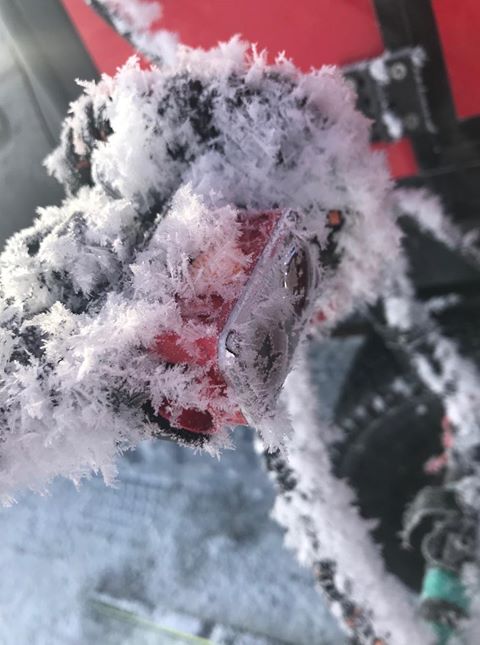LI-ION BATTERY AND FROST
Li-ion cells, like all other rechargeable batteries, do not like frost. Low temperatures increase the internal resistance of the battery and reduce the capacity. Li-ion batteries work in freezing temperatures, even at -20°C, but their usable capacity is lower (but not drastically so) and they are destroyed (aged) by such use. Prolonged use in freezing temperatures will irreversibly damage the battery and the available capacity will be lower.

WHAT IS THE TEMPERATURE LIMIT?
In all our sealed (=non-openable) batteries you will find Samsung INR18650-35E li-ion cells. The manufacturer specifies a temperature range of 10°C to 60°C(Operating temperature - discharge) in which the batteries can be used (discharged) and where their functionality is guaranteed. Panasonic, another big manufacturer of great 18650 batteries, specifies a discharge range down to -20°C. In my opinion Samsung is only stricter (more careful) in the specification, both batteries work even in -20°C. I will support my claim with a link to a battery test at https://lygte-info.dk/, where a Danish tester discharged a very similar Samsung INR18650-36G (3350mAh) battery in the freezer at -21°C and it gave a very solid capacity. Furthermore, the functionality is confirmed at -20°C by a pdf document from NASA called Performance and Safety of COTS 18650 Li-ion cells from Various Manufacturers examining in detail the Panasonic NCR18650A (3100mAh) cell. You can do the actual test yourself in the freezer where it is usually -18°C.
Recent studies even indicate that Li-ion are usable at -40°C, assuming very low discharge currents.
CAPACITY REDUCTION IN FREEZING TEMPERATURES
How much is the battery capacity reduced in freezing temperatures? This is not at all easy to answer, as the capacity also depends on the discharge current. And the graphs also show that if the discharge current is extremely high (e.g. 4A) then the battery will gradually warm up to normal temperature and maintain it.
Panasonic NCR18650GA - when discharging at 4A at 0°C the battery has 3080mAh, 92 .6% of capacity compared to 25°C. [5]
Panasonic NCR18650GA - when discharged at 4A at -10°C the battery has 2920mAh, 88% of capacity compared to 25°C [5].
Panasonic NCR18650B - when discharged at 3.3A at 0°C, the battery has 2950mAh, 90% capacity compared to 25°C. [4]
Panasonic NCR18650B - when discharged at 3.3A at -10°C, the battery has 2800mAh, 85% of capacity compared to 25°C. [4]
Panasonic NCR18650B - when discharged at 3.3A at -20°C, the battery has 2190mAh, 67% of capacity compared to 25°C. [4]
Panasonic NCR18650A - when discharged at 0.62A at 0°C, the battery has 2550mAh, 86% of capacity compared to 25°C. [2]
Panasonic NCR18650A - when discharged at 0.62A at -10°C, the battery has 2400mAh, 80 .5% of capacity compared to 25°C. [2]
Panasonic NCR18650A - when discharged at 0.62A at -20°C, the battery has 1400mAh, or 47% of capacity compared to 25°C. [2]
Panasonic INR18650-35E - when discharged at 3.4A at -10°C, the battery has 40% capacity compared to 25°C. [3]
DO YOU RUN THE BATTERY DOWN BY USING IT IN FREEZING WEATHER?
Yes, using a li-ion battery below 0°C will irreversibly destroy it (battery ageing). The lower the temperature, the more the battery ages. If the discharge current is low (e.g. C/10 = 0.34A) the damage is not great. In case of high discharge currents, the damage is already significant. However, there are also studies that indicate that higher discharge currents do not necessarily cause more damage than low discharge currents, because the battery can gradually warm up to a plus temperature with high current flow. Anyway, wherever the truth lies, the battery is damaged by use in sub-zero temperatures.
Much more damage is caused by charging cells in freezing temperatures, which causes layers to form on the electrode surface that reduce the available capacity.
HOW TO PROTECT BATTERIES FROM FREEZING?
You must always evaluate the conditions yourself. There is no need to hide the battery for short (30min) runs, it is unlikely to cool down in such a short time. For any longer activities in conditions where it is cold and even windy (the sensible temperature is even lower), then you need to either hide the battery under your outer layer of clothing or insulate it from the cold somehow, e.g. by using our softshell pocket.
If you're in a serious situation and need light, then of course forget the batteries and save your life, one use in freezing weather will not destroy or noticeably damage the battery. Only prolonged use will damage it.
SOURCES
[1] Battery University - Battery Testing and Safety, https://batteryuniversity.com/learn/article/battery_testing_and_safety
[2] Performance and Safety of COTS 18650 Li-ion cells from Various Manufacturers, PDF, NASA, 2013
[3] Specification of product Samsung INR18650-35E, PDF, Samsung SDI, 2015
[4] Specification of product Panasonic/Sanyo NCR18650B, PDF, Panasonic/Sanyo
[5] Specification of product Panasonic/Sanyo NCR18650GA, PDF, Panasonic/Sanyo
[6] Performance and Safety Testing of Panasonic 2.9Ah Li-ion NCR 18650 Cells, PDF, NASA, 2009